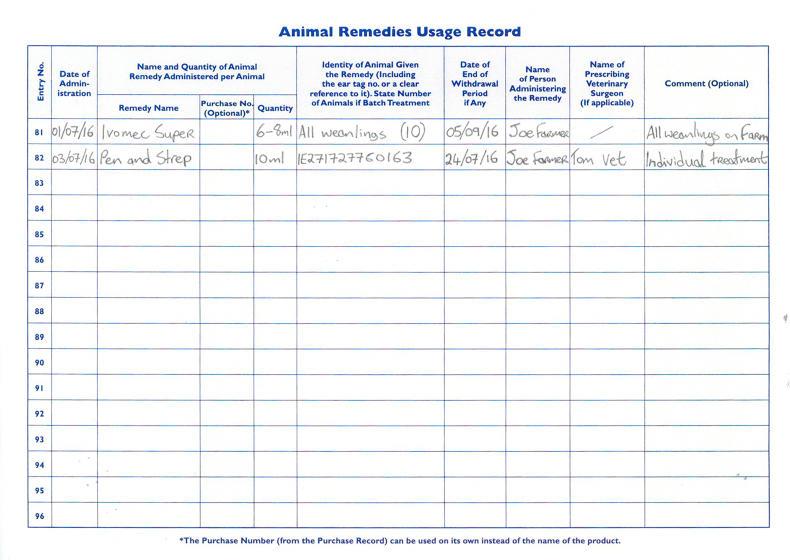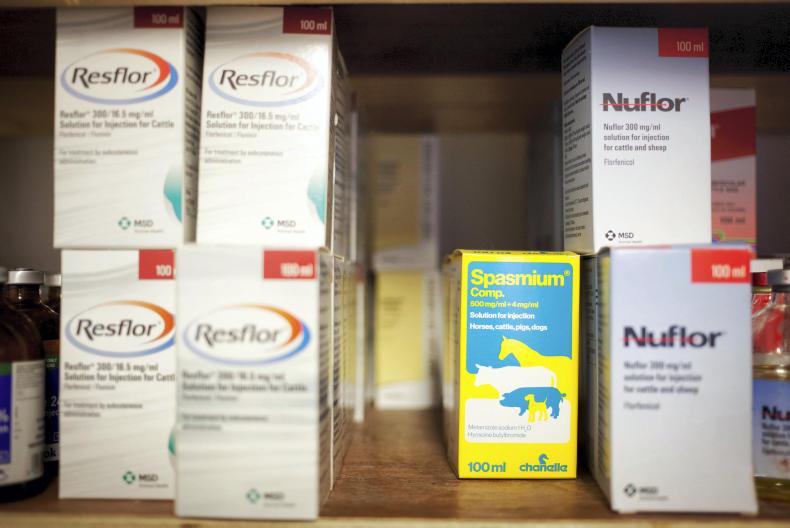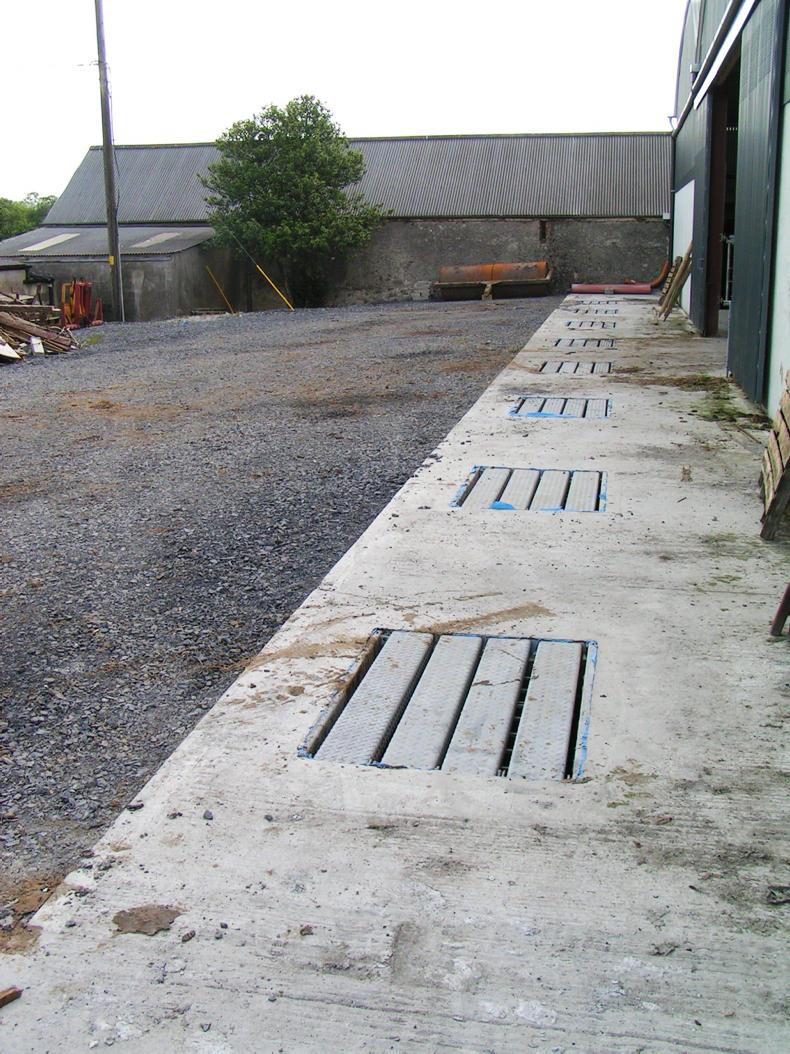Farmers should identify and eliminate any obvious pollution risks. Some pollution risks that should be avoided are leaking fuel tanks and burning plastics. With heavy rain over the past few weeks, silage effluent and slurry run-off can be a major issue. This has been one of the areas that farmers have fallen back on. Farmers yet to make silage are urged to be wary of the risk of water pollution.
Improper use and storage of animal remedies is another major area that farmers tend to fail audits on. Records must be filled in correctly and should contain: date of purchase, medicine name, quantity purchased and who it was supplied by.
The remedy purchase records must also bear resemblance to the remedy usage records.
Failure to record medicine purchases can contribute to non-compliance to the scheme and the risk of failing the audit. The amount each animal receives along with the animal tag number should be recorded.
Auditors also look to see where needles are stored.
Animal remedies must be stored independently from other substances or chemicals in a secure medicines store.
This can be a specially designed store or steel container, or other storage device that can be secured. An old fridge is also commonly used among farmers.
All medicines must be in-date and their purchase date recorded. Medicines out of date must be separated and kept until safe disposal is available.

Auditors also look to see where needles are stored.
Needles should be stored in their own labelled box. Used needles should be stored in a safe, secure location until disposal. Some vets may take used needles back off farmers.

The farmer should take time to examine the farm and eliminate any safety risks.
A farm safety risk assessment document should then be completed and should also be available for inspection on the day of the audit.
On inspection, the auditor will examine the farm for obvious safety hazards. Serious hazards will result in a non-compliance. Signs such as ‘beware of the bull’, medicine/chemical store, first aid, etc, will help convey a greater sense of compliance. An example of some of the most common major health and safety non-compliances on farms are:
Broken and missing PTO shafts/covers.Slurry lagoons not fenced/safe and missing agitation point covers.Post-inspection: After the inspection report is submitted, the details go through several different steps before final decision. Just because the inspection is completed, doesn’t mean it is the end of the process. The entire process from application through to final certification can take up to five weeks to complete. Not until the farmer receives a letter outlining an official certification status should animals be sent to slaughter.

Required documents
The following documents need to be available to the inspector to view during the inspection.
1. Animal remedy prescriptions .
2. Valid herd register/flock register.
3. Animal movement records.
4. Passports/blue cards.
5. Knackery/dead animal receipts.
6. Animal remedy purchase records.
7. Animal remedy usage records.
8. Recent feed delivery dockets.
9. If feeds are purchased and no docket is available, enter the feeds purchased in the feed purchases record in the Bord Bia farm book.
10. Up to date own farm feeds record.
11. Up-to-date animal health plan.
12. Animal mortality and significant health issues record.
13. Sign at entry to farmyard restricting unauthorised personnel and alerting visitors to observe biosecurity measures and the availability of the safety statement.
14. Footwear disinfectant facilities.
15. Farm safety risk assessment or farm safety statement document.
16. First aid kit readily available.
17. Farmyard sketch of bait points.
18. Waste plastic collection receipts from approved collectors.
19. Name of veterinary services providers, veterinary product suppliers, hauliers and any persons applying pesticides.
20. Pesticide usage records.
Members in the beef lamb QA scheme – 51,000
Members in the dairy scheme – 15,000
How many audits carried out so far – 7,700
How many audits carried out per week – 700
How many auditors are carrying out inspections – 100
What percentage of people passed first time – 90%
Auditors also look to see where needles are stored.
Read More
Improving milk protein percent
Watch: grass supply and quality at higher stocking rates on Dairylink farms
Farmers should identify and eliminate any obvious pollution risks. Some pollution risks that should be avoided are leaking fuel tanks and burning plastics. With heavy rain over the past few weeks, silage effluent and slurry run-off can be a major issue. This has been one of the areas that farmers have fallen back on. Farmers yet to make silage are urged to be wary of the risk of water pollution.
Improper use and storage of animal remedies is another major area that farmers tend to fail audits on. Records must be filled in correctly and should contain: date of purchase, medicine name, quantity purchased and who it was supplied by.
The remedy purchase records must also bear resemblance to the remedy usage records.
Failure to record medicine purchases can contribute to non-compliance to the scheme and the risk of failing the audit. The amount each animal receives along with the animal tag number should be recorded.
Auditors also look to see where needles are stored.
Animal remedies must be stored independently from other substances or chemicals in a secure medicines store.
This can be a specially designed store or steel container, or other storage device that can be secured. An old fridge is also commonly used among farmers.
All medicines must be in-date and their purchase date recorded. Medicines out of date must be separated and kept until safe disposal is available.

Auditors also look to see where needles are stored.
Needles should be stored in their own labelled box. Used needles should be stored in a safe, secure location until disposal. Some vets may take used needles back off farmers.

The farmer should take time to examine the farm and eliminate any safety risks.
A farm safety risk assessment document should then be completed and should also be available for inspection on the day of the audit.
On inspection, the auditor will examine the farm for obvious safety hazards. Serious hazards will result in a non-compliance. Signs such as ‘beware of the bull’, medicine/chemical store, first aid, etc, will help convey a greater sense of compliance. An example of some of the most common major health and safety non-compliances on farms are:
Broken and missing PTO shafts/covers.Slurry lagoons not fenced/safe and missing agitation point covers.Post-inspection: After the inspection report is submitted, the details go through several different steps before final decision. Just because the inspection is completed, doesn’t mean it is the end of the process. The entire process from application through to final certification can take up to five weeks to complete. Not until the farmer receives a letter outlining an official certification status should animals be sent to slaughter.

Required documents
The following documents need to be available to the inspector to view during the inspection.
1. Animal remedy prescriptions .
2. Valid herd register/flock register.
3. Animal movement records.
4. Passports/blue cards.
5. Knackery/dead animal receipts.
6. Animal remedy purchase records.
7. Animal remedy usage records.
8. Recent feed delivery dockets.
9. If feeds are purchased and no docket is available, enter the feeds purchased in the feed purchases record in the Bord Bia farm book.
10. Up to date own farm feeds record.
11. Up-to-date animal health plan.
12. Animal mortality and significant health issues record.
13. Sign at entry to farmyard restricting unauthorised personnel and alerting visitors to observe biosecurity measures and the availability of the safety statement.
14. Footwear disinfectant facilities.
15. Farm safety risk assessment or farm safety statement document.
16. First aid kit readily available.
17. Farmyard sketch of bait points.
18. Waste plastic collection receipts from approved collectors.
19. Name of veterinary services providers, veterinary product suppliers, hauliers and any persons applying pesticides.
20. Pesticide usage records.
Members in the beef lamb QA scheme – 51,000
Members in the dairy scheme – 15,000
How many audits carried out so far – 7,700
How many audits carried out per week – 700
How many auditors are carrying out inspections – 100
What percentage of people passed first time – 90%
Auditors also look to see where needles are stored.
Read More
Improving milk protein percent
Watch: grass supply and quality at higher stocking rates on Dairylink farms









 This is a subscriber-only article
This is a subscriber-only article










SHARING OPTIONS: